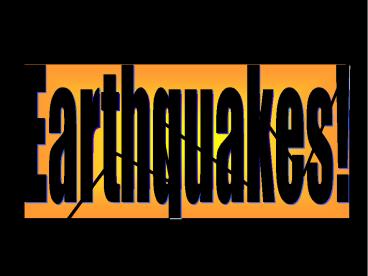Earthquakes! - PowerPoint PPT Presentation
Title: Earthquakes!
1
Earthquakes!
2
Big Ideas...
- What is an earthquake?
- What causes earthquakes?
- How are earthquakes measured?
- What areas are more susceptible to an earthquake?
Why? - What does an earthquake feel like?
3
Deadliest Earthquakes
The earthquake that caused the most destruction
in history occurred in the Shansi province of
China on January 23,1556. An estimated 830,000
people were killed. The second most destructive
earthquake also occurred in China--in July,
1976--and killed 255,000 people.
4
Recent 'Quakes
-900 -600
-300 -150 -70
-33 0
5
Recent 'Quakes
6
Worldwide 'Quakes
7
(No Transcript)
8
What is an Earthquake?
The definition of an earthquake is vibrations
that cause the breaking of rocks. These
vibrations move in all directions through the
earth. They begin at a point along a fault.
9
How do faults form?
The earths crust is constantly experiencing
pressure from forces within and around it. This
pressure builds up over time, and eventually
causes the crust to break. This becomes a fault.
10
What is an Earthquake?
An earthquake begins along a fault (a crack in
the earths surface) at a point called the focus.
Directly above the focus is a point on the
earths surface called the epicenter.
11
Where does an earthquake begin?
Epicenter
Focus
12
Why is the epicenter important?
Seismologists have stations all over the world
that continuously collect information about
earthquakes. This kind of information can help
scientists figure out where larger, more
destructive earthquakes may strike by mapping out
the location of smaller quakes. They also get
a greater understanding of the changes the
earths crust makes as the earthquakes
occur. How do they do this???
13
What is an Earthquake?
When the fault ruptures with a sudden movement
energy is released that has built up over the
years. This energy is released in the form of
vibrations called 'seismic waves'
earthquakes! It is actually when these seismic
waves reach the surface of the earth that most of
the destruction occurs, which we associate with
earthquakes.
14
What Kind of Damage Do They Do?
Earthquakes can cause landslides, sudden
eruptions as in the case of a hot lava flow from
a volcano or giant waves called tsunamis.
Sometimes new land mass are also formed. Such
earthquakes are attributed with the creation of
the greatest undersea mountain range and the
longest land mountain range.
15
San Francisco, 1989
16
San Francisco, 1989
17
San Francisco, 1989
18
San Francisco, 1989
19
San Francisco, 1989
20
San Francisco, 1989
21
San Francisco, 1989
22
San Francisco, 1989
And that was just a 7.2 on the Richter scale!
23
How are earthquakes measured?
Earthquakes are measured using the Richter Scale.
The strongest earthquake ever measured was a 9.5
on the Richter Scale. This is a measurement of
the amount of energy released from the
earthquake.
24
Strongest Earthquakes
9.5 Chile, May 22, 1960 9.2 Indian Ocean
(Sumatra tsunami) Dec 26,2004 9.2 Prince William
Sound, Alaska, March 28, 1964 9.1 Andreanof
Islands, Aleutian Islands, Pacific, March 9,
1957 9.0 Kamchatka, Russia, November 4,
1952 8.8 Off the Coast of Ecuador, January 31,
1906 8.7 Rat Islands, Aleutian Islands,
Pacific, February 4, 1965 8.6 India-China
Border, August 15, 1950 8.5 Kamchatka, Russia,
February 3, 1923 8.5 Banda Sea, Indonesia,
February 1, 1938 8.5 Kuril Islands, Pacific,
October 13, 1963
25
Magnitude is a number that characterizes the
relative size of earthquakes is proportional
to energy released
26
...and in the 48 states
In the lower 48 states, there is a tie between
the February 1812, New Madrid, Missouri
earthquake and the January 1857, Fort Tejon,
California earthquake--both magnitude 7.9--for
the strongest earthquake recorded.
27
Mercalli Scale
28
What Does an Earthquake Feel Like?
Generally, during an earthquake you first will
feel a swaying or small jerking motion, then a
slight pause, followed by a more intense rolling
or jerking motion. The duration of the shaking
you feel depends on the earthquake's magnitude,
your distance from the epicenter, and the geology
of the ground under your feet.
29
How Long Does an Earthquake Last?
- For minor earthquakes, ground shaking usually
lasts only a few seconds. - Strong shaking from a major earthquake usually
lasts less than one minute. For example, shaking
in the 1989 magnitude 7.1 Loma Prieta (San
Francisco) earthquake lasted 15 seconds - For the 1906 magnitude 8.3 San Francisco
earthquake it lasted about 40 seconds. - Shaking for the 1964 magnitude 9.2 Alaska
earthquake, however, lasted three minutes.
30
What is an aftershock?
Aftershocks are smaller earthquakes which occur
in the same general area during the days to years
following a larger event or "mainshock". As a
general rule, aftershocks represent minor
readjustments along the portion of a fault that
slipped at the time of the main shock. The
frequency of these aftershocks decreases with
time.
31
Earthquake Predictors?
Often, earthquakes can be a sign of things to
come, like in the case of Mt. St. Helens in
Washington.
32
Mt. St. Helens
This photograph was taken during the 1980
eruption. Is this volcano active again??? The
seismic data saysYES!
33
Mt. St. Helens
After
Before
34
Volcanoes...
Notice, this volcano really blew its top
literally!
Mt. St. Helens Today































